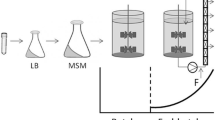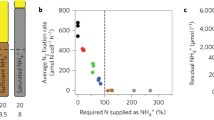Abstract
The growth rates of the methane oxidizing strain M 102 were unstable. In unlimited batch cultures they ranged from 0 to 1.4 d-1 with most frequent values around 0.25 d-1. The yield coefficients were between 0.1 and 1.6 mg dry weight per mg methane and varied from 1.1 to 0.4 even in a continuous culture with the limiting substrate in the gas phase. It was possible to prove intermitten release and uptake of organic compounds by the definition of a “net” yield coefficient and its theoretical boundaries. The response of the fluctuations to varying dilution frequencies and culture volumes showed analogies to controlled systems. The simultaneous variations in the age distribution and in the excretion pattern revealed the dependence of the dividing stages on a product of the young cells. The mathematical description of the findings suggests that the young cells favor division at their own disadvantage. The consequent autonomous synchronisations are the reason for the unstable growth rates of strain M 102.
Similar content being viewed by others
Abbreviations
- a :
-
Rate of transitions to dividable cells, i.e., of growth in volume (per time)
- A :
-
equilibrium value of a
- b :
-
rate of transitions to dividing stages (per time)
- B :
-
equilibrium value of b
- c :
-
rate of divisions, i.e. growth in numbers (per time)
- C :
-
equilibrium value of c
- d :
-
day
- D :
-
dilution rate (per time)
- e :
-
base of the system of natural logarithms (= 2.71828)
- E :
-
extinction at 546 nm in a 1 cm light path, corrected for non-linearities above 0.3. 11 culture with a extinction of 1 contains 625 mg dry weight of bacteria
- f :
-
Control time parameter (-)
- F culture, gas :
-
flow of culture medium, resp. gas phase (volume per time)
- g :
-
control time parameter (-)
- k :
-
partition coefficient (concentration in solution/concentration in gas phase)
- k O 2, CH4 :
-
0.3 mlO 2, CH4/lsolution/volume % in gas phase (1 atm., 21° C)
- K :
-
parameter characterizing the gas exchange conditions (volume per time)
- K S :
-
half saturation constant (concentration); m factor modifying the concentration of gaseous limiting nutrients in culture suspension [Eq. 5.3)]
- μ:
-
growth rate (per time)
- μm :
-
maximum growth rate (per time)
- n :
-
factor converting true to apparent concentration of limiting substrate in gas inflow [Eq. (5.2)]
- P R i :
-
portion of cell stage i at equilibrium (t≥t R )
- q :
-
625 mg dry weight of bacteria/E/lculture
- s 1, 2, 3, r :
-
concentration of limiting substrate, 1 in gas inlet, 2 in gas outlet, 3 in culture suspension, r in inflow of culture medium
- S in, out, used :
-
amount of substrate per time and per volume of whole culture in: entering culture, out: leaving culture, used: transformed within culture
- t :
-
time
- t R :
-
control time
- V :
-
volume of whole culture
- y CH 4,O2 :
-
yield coefficient of methane, resp. oxygen
- z 1,2,3,g,i :
-
number of cells per volume of culture, 1 adolescent cells (length below 1.6 μm), 2 dividable cells (lenght 1.6 μm or more), 3 dividing cells (two connected spheres), g all cell stages (1+2+3), i cell stage i (1,2 or 3)
References
Bergter, F.: Produktinduzierte Oszillationen der Zelldichte von Streptococcus pyogenes im Chemostaten. Z. Allg. Mikrobiol. 13, 725–727 (1973)
Bewersdorf, M., Dostalek, M.: The use of methane for production of bacterial protein. Biotechnol. Bioengin. 13, 49–62 (1971)
Bielka, H.: Molekulare Biologie der Zelle, 2. Auflage. Stuttgart: Fischer 1973
Dean, A. C. R., Hinshelwood, G.: Growth function and regulation in bacterial cells. Oxford: Clarendon Press 1966
Ecker, R. E., Lockhart, W. R.: Influence of initial population on the lengh of lag. Bact. Proc. 1960, 165 (1960)
Harwood, J. H., Pirt, S. J.: Quantitative aspects of growth of the methane oxidizing bacterium Methylococcus capsulatus on methane in shake flask and continuous chemostat culture. J. Appl. Bact. 35, 597–607 (1972)
Hess, B., Boiteux, A.: Oscillatory phenomena in biochemistry. Ann. Rev. Biochem. 40, 237–258 (1971)
Jannasch, H. W.: Methane oxidation in Lake Kivu (Central Africa). Limnol. Oceanogr. 20, 860–864 (1975)
Kraepelin, G., Franck, G.: Self-synchronization in yeast and other fungi. Int. J. Chronobiol. 1, 163–172 (1973)
Monod, J.: Recherches sur la croissance des cultures bactériennes (Thèse), 2. Ed. Paris: Hermann 1958 (1942)
Naguib, M.: On methane-oxidizing bacteria in fresh waters. III. The capacity of methane-oxidizing enrichment cultures as revealed by gaschromatographic analyses. Z. Allg. Mikrobiol. 11, 39–47 (1971)
Naguib, M.: Overall metabolic regulations in cultures of the obligate methane-oxidizing strain M. 102. Proc. Internat. Symp. “Microbial Growth on C1-Compounds”, pp. 203–212. Intersectional Congress of the IAMS. Tokyo, Japan, 1974. Published by the Society of Fermentation Technology, Japan (1975)
Overbeck, J., Ohle, W.: Contributions to the biology of methane-oxidizing bacteria. Verh. Internat. Verein. Limnol. 15, 535–543 (1964)
Pato, M. L.: Regulation of chromosome replication and the bacterial cell cycle. Ann. Rev. Microbiol. 26, 347–368 (1972)
Pfennig, N., Jannasch, H. W.: Biologische Grundfragen bei der homokontinuierlichen Kultur von Mikroorganismen. Ergebn. Biol. 25, 93–135 (1962)
Ribbons, D. W., Harrison, J. E., Wadzinski, A. W.: Metabolism of single carbon compounds. Ann. Rev. Microbiol. 24, 135–158 (1970)
Röhler, R.: Biologische Kybernetik, Regelungsvorgänge in Organismen. Stuttgart: Teubner 1974
Rossolimo, L., Kusnetsova, S.: Die Bodengasausscheidung als Faktor des Sauerstoffhaushaltes der Seen [in Russ.]. Arb. Limnol. Stat. Kossino 17, 87–112 (1934)
Rudd, J. W., Furutani, A., Flett, R. J., Hamilton, R. D.: Factors controlling methane oxidation in shield lakes: The role of nitrogen fixation and oxygen concentration. Limnol. Oceanogr. 21, 357–364 (1976)
Sheehan, B. T., Johnson, M. J.: Production of bacterial cells from methane. Appl. Microbiol. 21, 511–515 (1970)
Shulgovskaya, E. M., Ivanova, J. J., Sotnicov, G. G.: Exponential growth phase of Pseudomonas methanolica batch cultures. Z. Allg. Mikrobiol. 13, 523–528 (1973)
Van Uden, N.: Thermodynamics of the chemostat. Z. Allg. Mikrobiol. 11, 541–550 (1971)
Walker, J. R., Reeves, J. B., Lankford, C. E.: Kinetics of production of endogenous cell division activators in relation to inoculum density. Bact. Proc. 1962, 37 (1962)
Wilkinson, T. G., Harrison, D. E. F.: The affinity for methane and methanol of mixed cultures grown on methane in continuous culture. J. Appl. Bact. 36, 309–313 (1973)
Yano, T., Koga, S.: Dynamic behavior of the chemostat subject to product inhibition. J. gen. appl. Microbiol. 19, 97–114 (1973)
Author information
Authors and Affiliations
Rights and permissions
About this article
Cite this article
Krambeck, C., Krambeck, H.J. & Overbeck, J. Autonomous growth fluctuations of the methane oxidizing bacterial strain M 102 in batch and continuous culture. Arch. Microbiol. 115, 119–126 (1977). https://doi.org/10.1007/BF00406364
Received:
Issue Date:
DOI: https://doi.org/10.1007/BF00406364




